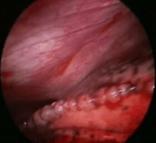
Natural orifice transluminal endoscopic surgery is a technique of surgery whereby "scarless" abdominal operations can be performed with an endoscope passed through a natural orifice (mouth, urethra, anus, etc.) then through an internal incision in the stomach, vagina, bladder or colon, thus avoiding any external incisions or scars.
It usually raises many questions about its usefulness, appropriateness, applicability and future after the establishment of a new surgical concept. The development of minimally invasive surgery is a distinctive example.
To shake the surgical community Laparoscopic cholecystectomy was the first tremor. The incidence of complications very clearly depended on the surgeon’s experience and these would have a major impact not only on the patient, but on the medico-legal aspects of surgery. The surgical community has been stimulated by these events into redefining the way a new technique should be developed and propagated, and the necessity has been shown to them of developing new methods for education and training. Incorporating these methods into the traditional educational system and training already established surgeons inspired various initiatives. Then there were Multiple and varying teaching methods of these new techniques offered.

Bringing back surgical training to the experimental operation theater was the most common change, as the first step to learning these new techniques. Training on animal models helped to overcome the hurdles laid out by surgery in a new environment. The gradual implementation of the skills acquired in the laboratory would then allow a more secure clinical application of the surgical procedures learnt.
Through the use of the Internet and pace of development the second initiative was to utilize the revolution that had occurred to media. Indeed, this revolution rendered information and educational resources accessible to more people; the traditional barriers that borders and continents are out of fashion. The conjunction of this new way of communication and of the technical characteristics of laparoscopic surgery, i.e. using video recorded images to perform an operation, has provided significant educational material that some centers rapidly included in their educational program. The ability and potential of a training center combining a virtual university and an institute for training in surgery has been sufficiently demonstrated by a number of institutes.
Are we at the first light of a new surgical revolution with the emergence of surgical procedures performed via natural orifices, commonly referred to as NOTES? Even if the application of NOTES remains rare in clinical settings, should all the training means available be solicited for education in this field? Should we wait for concerns similar to when laparoscopic cholecystectomy was introduced? Due to engagement of two medical groups NOTES is different to laparoscopy: the gastro-enterologists and the surgeons. It implies, what training should be offered to the one or to the other? Who should practice NOTES? Are the common questions.

The sheer amount of questions is fascinating and this era of concern can be closely assimilated to the anarchical beginnings of modern era of laparoscopic surgery.
The gastro-enterologists are less convinced that NOTES has potential, perhaps they are more reserved, or perhaps not inclined to train with surgeons, or maybe even not very prone to see surgeons train with flexible endoscopes. These opinions vary from person to person and institution also.
The amount of support gathered by these varied educational methods is certainly a unique situation: To train on a technique of NOTES potential operators wish to get information and that is still just a concept. However, this depicts the willingness of physicians to learn natural orifices transluminal endoscopic surgery when it comes to acquiring skills that would allow them to integrate easily in an innovating and promising area of surgery. This response shows that the lessons arising from the introduction of laparoscopic cholecystectomy have been learned, and corroborates the educational and training decisions made by the specialized centers.





